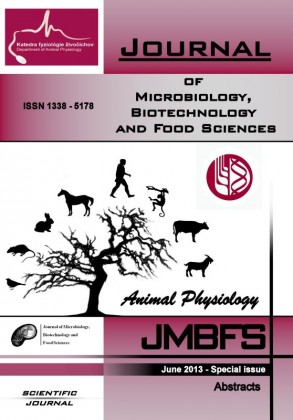INFLUENCE OF ELECTROMAGNETIC RADIATION ON TESTICULAR STRUCTURE AND STEROIDOGENESIS IN RATS
Keywords:
electromagnetic radiation, testes, structure, testosterone, ratsAbstract
In the new era of intensive usage of modern electronic devices everybody is influenced by an accumulating effect of electromagnetic radiation (EMR) more widely than ever in the past. EMR is a self-propagating wave in space with electric and magnetic components and is physically classed as non-ionising radiation. The immediate whole body electromagnetic radiation – EMR was used to investigate testicular structure and testosterone synthesis of the Wistar rats. Sexually mature (48 days old) rats were subjected to pulsed electromagnetic fields at frequency of 2.45 GHz and mean power density of 2.8 mW/cm2 for 3 h per 3 weeks. Histological structure of the testicular parenchyma and plasma testosterone concentrations were evaluated in 21 days post irradiation. The light microscopy revealed moderate degenerative changes in testicular parenchyma as well as decreased plasma testosterone levels in experimental animals compared to the control counterpart which indicate an adverse effect of EMR on spermatogenesis and steroidogenesis in rats. These findings confirmed the evidence, that the testes are amongst the most susceptible organs to the EMR. Next studies are required for elucidation of relation between the EMR and widely debated disorders of fertility and fecundity not only in the human population.Downloads
Download data is not yet available.
Downloads
Published
2013-06-06
How to Cite
Almášiová, V., Holovská, K., Cigánková, V., & RaÄeková, E. (2013). INFLUENCE OF ELECTROMAGNETIC RADIATION ON TESTICULAR STRUCTURE AND STEROIDOGENESIS IN RATS. Journal of Microbiology, Biotechnology and Food Sciences, 2(Abstracts special issue), 1. Retrieved from https://office2.jmbfs.org/index.php/JMBFS/article/view/7506
Issue
Section
Biotechnology
License
Copyright (c) 2013 Viera Almášiová, KatarÃÂna Holovská, Viera Cigánková, Enikö RaÄeková

This work is licensed under a Creative Commons Attribution 4.0 International License.
All papers published in the Journal of Microbiology, Biotechnology and Food Sciences are published under a CC-BY licence (CC-BY 4.0). Published materials can be shared (copy and redistribute the material in any medium or format) and adapted (remix, transform, and build upon the material for any purpose, even commercially) with specifying the author(s).

